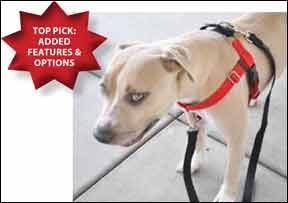I’m sitting at my desk, which is piled high with control-type walking harnesses for dogs, and reveling at how this market niche has expanded since the introduction of the first front-clip model, the SENSE-ation Harness, more than a decade ago. It’s hard evidence of the growth of positive reinforcement-based training, and confirms a robust desire on the part of dog owners to find gentler and more effective ways to work with their canine companions.

Once upon a time, a harness was the last thing you wanted to use for a dog who pulled, because they were designed to make pulling comfortable. By distributing pressure evenly across the chest they removed pressure from the throat, where damage could be done to a dog’s trachea – sometimes even to the point of tracheal collapse. Harnesses are better for the dog from a health perspective, but from a training viewpoint, a standard harness actually encourages pulling. There’s a reason sled dogs wear harnesses!
Head halters were introduced in the late 1990s as a gentle control tool. While they did, indeed, work well to control a dog’s head (and where the head goes, the body follows), some trainers noticed that a significant number of dogs found head halters to be fairly aversive, requiring, in many cases, extensive conditioning to convince the dog to accept them. Thus, the SENSE-ation Harness was introduced by the folks at Softouch Concepts, Inc., as a more dog-friendly walking tool, while still following the “control-the-front-end” concept. Reception from the training community was lukewarm at first, but trainers eventuallybegan test-driving them and discovered that they were, indeed, an effective tool, and that most dogs accepted them easily, with little or no conditioning needed.

A clear sign of the success of the product was the advent of a slew of imitators. Within a few years several competing products arrived on the shelves, and the market has continued to evolve. There are several brands for the training harness aficionado to select from, each with its own variation on the no-pull theme.
We recently acquired samples of eight models of training harnesses and evaluated them on construction and materials, ease of use, effectiveness, and cost, to arrive at our “Top Pick” choices. Our findings appear on the following pages, from least to most expensive (prices may vary from different sources).
Petco Non-Pull Harness, $20
Discourages pulling with straps that go under the dog’s armpits and tighten when tension is put on the leash. The leash attaches to a ring at the dog’s back.

-Construction and Materials: This harness seems reasonably solid, although “Made in China” can sometimes indicate poor construction. There are no snaps to accidentally pop open, but the plastic adjustment buckles and the metal hardware appear to be made of low-grade materials. An elastic piece across the chest improves the comfort. The flat nylon straps are a nice medium weight and moderately soft. We like the fleece tubes covering the leg straps to protect the dog’s armpits from chafing, but the straps themselves are narrow (skinny straps inflict more discomfort if the dog pulls) and not particularly strong. A dog whose owner is inattentive could bite through them in a hot second. Three sizes.
-Ease of Use: To put on the dog, you slide this harness over his head, then guide his legs through the straps. This is difficult with the high-energy dogs who need a control harness! Instructions included are minimal, and make no suggestions for training, other than a small-print caveat “intended for short-term training use only.”

-Effectiveness: We’re not fans of the Petco No-Pull harness. While the novelty of the under-the-leg pressure can inhibit the dog’s movement (and therefore, pulling) initially, many dogs quickly habituate to the sensation and thus the harness rapidly loses effectiveness. Also, having the single point of contact in the middle of the dog’s back allows for little control, especially if he spins.
-Comments: I would not choose this harness for my dogs or recommend it for my clients’ dogs.
Halti Harness, $20
Don’t confuse this with the Halti Head Halter! This is a standard front-clip style harness made in the United Kingdom.
-Construction and Materials: The nylon straps of this harness are a nice weight, and softer than the Petco No-Pull, while the hardware, both plastic and metal, also appears to be better quality. We especially like the padding stitched in for extra comfort at the joining of the chest and belly straps. A nice feature unique to this harness is the metal clip on the chest strap, which can be used to attach to the dog’s regular flat collar – both to help keep the harness in place as well as act as a “safety belt” attachment should the dog manage to wriggle out of the harness. We also like the addition of a ring on the back strap, which provides two points of contact and allows for greater control.

However, we find the martingale loop on the chest strap (which provides a tightening or squeezing action when the dog pulls and the leash tightens) to be unnecessary and bulky. Three sizes.
-Ease of Use: The single snap style makes this harness relatively easy to put on – just slip the belly strap over the dog’s head with the ring on top, and connect the snap underneath the dog. When connected the snap is low enough on the strap to avoid chafing under the arm. Buckles adjust easily (three points of adjustment provide a good fit for all shapes of dogs), and a detailed booklet offers good instructions for use.
-Effectiveness: This harness worked well for us, other than a little annoying bunching of the small martingale loop, and an overlong strap that wanted to dangle when its loose-fitting nylon keeper failed to do its job. If we were using this harness on a regular basis we would cut the strap to shorten it, and stitch it down.

-Comments: I would use the Halti harness.
Sense-Ible Harness, $23 +/- and Sense-Ation Harness, $25 +/-
The folks at Softouch Concepts, Inc. were the creators of the original front-clip harness design, and we owe them our heartfelt thanks for that. The SENSE-ation was their first product; they added the SENSE-ible, using less-expensive material and offering fewer size and color choices, so they could offer a harness at a lower price point.
-Construction and Materials: Both harnesses are made of good quality, soft nylon, and good quality plastic and metal hardware; they are made both in the U.S. and in China. Both styles are available in multiple sizes; price varies slightly, with smaller sizes costing less.
-Ease of Use: Again, a single snap design makes this an easy harness to put on the dog; just open the snap, slip the harness over the dog’s head, and connect the snap underneath. The snap is low enough on the strap to avoid chafing under the dog’s front legs. Three points of adjustment provide a good fit for all shapes of dogs. The plastic slide buckles on the slightly more expensive SENSE-ation adjust easily; the metal slide buckles on the SENSE-ible required a bit of struggle. A multi-page packet of information came with these harnesses, offering in-depth information about fitting and proper use.

-Effectiveness: The first time I used a SENSE-ation harness, I was speaking at a seminar, and a shelter brought a strong, adolescent Doberman on a prong collar for me to work with. I asked the handlers to remove the prong collar, and it was suggested that I would not be able to hold him. They were correct; he could drag me on his flat collar. I just happened to have a SENSE-ation harness with me, and I put it on the dog. I was able to finish my talk while holding the dog’s leash with one finger. These are very effective at controlling a dog who tries to pull.
-Comments: I would use either of these harnesses, but prefer the SENSE-ation for ease of adjustment.
Walk Your Dog With Love, $27
This is simplest of the harnesses we reviewed. It’s a front-clip style, made in the U.S.
-Construction and Materials: This harness is made of a different material than any of the other products; instead of using some form of nylon, the maker uses polypropylene citing its resistance to stretching under tension and its lack of absorbency of moisture. (When a nylon harness gets wet, it becomes heavy with moisture; polypropylene does not. Also, supposedly, polypropylene does not absorb odorous oils from the dog’s coat, and won’t require frequent washing to keep it from getting smelly.) Owners who are used to softer nylon products (like myself!) may not like the feel of this stiffer material.

The straps are wide, to prevent them from being too severe or cutting into the dog’s flesh. However, I am concerned that the stiffness of the material, as well as a buckle placed near the dog’s elbow, could cause chafing problems. I didn’t test the harness for long enough to determine if this occurs; the manufacturer, of course, says he has not found this to be the case.
There are bits of reflective tape on both side straps and the front strap of the harness, which provide visibility during nighttime walking – a nice touch.
The harness is meant to be minimalist, and can be adjusted in just two places: the dog’s girth and on the front of the chest. However, I found that if the dog isn’t one of the bulkier breeds, and the chest strap had to be tightened a lot in order to fit the dog snugly, the strap in the front dangled so much as to be awkward. The harness is available in multiple sizes.

-Ease of Use: This harness is easy to put on the dog, with the one-snap over the head style common to several of the harnesses. The belly strap was easy to adjust; the front strap, with two layers of nylon, was a little harder, but still easier than the SENSE-ible’s metal buckles. Only very perfunctory fitting instructions, and direction to the product website, were provided with the harness.
-Effectiveness: Other than the extra length of strap in front, which we found annoying, this harness worked well to discourage our test dogs from pulling.
-Comments: WDJ Editor Nancy Kerns and I were evenly split about recommending this harness. I found the polypropylene straps to be very off-putting; I have seen enough chafing issues even with softer materials to expect problems with this one. However, Nancy Kerns has been using the harness for walking shelter dogs who pull, and appreciates the simplicity and ease of adjustment specifically for use on a variety of dogs (where she needs to make quick adjustments from dog to dog) and for very short distances (where chafing is not an issue).

0)]
Freedom Harness, $30+-
Full disclosure: This is the harness I currently use and sell at my training center. A front-clip style, it has several unique features and options that I like.
-Construction and Materials: This harness is made in the U.S. of good quality material – a wide but soft nylon webbing, covered with velveteen where the strap passes under sensitive armpits – no chafing here!
This harness has two points of contact: a ring on the front of the dog’s chest, and one with a martingale loop on the top of the dog’s back, which offers a slight tightening sensation effect to the front-clip function. The hardware is robust and sturdy, with two plastic snaps rather than one; the snaps sit well above the dog’s elbow. Available in multiple sizes.
-Ease of Use: Much as we like this harness, we have to admit that it is more complicated than several of the others. The two-snap design invites confusion, and some of my trainers tell me it’s too complicated for some of their students. This harness was accompanied by a well-written brochure with easy-to-follow instructions. The maker will replace up to two chewed straps for just the cost of shipping.
-Effectiveness: This harness fits well and works well. If you use the double-ended leash that you can purchase with it (optional) it’s almost like holding the reins of a horse – although, again, some owners find that too complicated, especially if they are also trying to hold onto a clicker and treats.
-Comments: I love this harness for myself. While I’m not usually a fan of martingale straps (seen in the photo at right – the loop at the top of the dog’s back), this one performs well and does not bunch up as it tightens (when the dog pulls) and relaxes (when the leash is slack). We get mixed reviews from clients because of the increased complexity of the harness.

1)]
Easy Walk Harness, $30
Brought to you by Premier Pet Products and made in Taiwan, this was another early entrant to the control-harness market. There are two clips on the girth strap (one above the chest strap and one below it) and a martingale loop in the front chest strap.
-Construction and Materials: The nylon used here has a slightly harder edge than the two SENSE-harnesses or the Freedom. The plastic snap attached to the belly strap sits immediately under the dog’s right elbow and may chafe. Available in multiple sizes.
-Ease of Use: Although this harness has two snaps, it’s designed so that you only undo one – allowing you to undo the bottom snap to slip it over the dog’s head to put it on and take it off easily, or if you choose, undo the upper snap and have your dog step in or out of it. Still, having two snaps always complicates things, and increases the odds that someone will get confused. Personally, I have always found the front martingale strap (a loop that tightens if the dog pulls) to be a bother. As you can see from the photo, when fitted tightly enough to keep it from sagging down the dog’s chest, it pulls the girth
strap forward, which interferes with the dog’s shoulder action and pinches behind the elbow. A detailed instruction pamphlet was included in the packaging with this product.
-Effectiveness: If properly fitted, this harness works well, although you must be on guard for chafing.
-Comments: Not one of my favorites, in large part because of the martingale loop. (Note: Runs small. The “medium” size was far smaller than the other products’ “medium.”)
Dean & Tyler No-Pull, $55
As the price suggests, this harness is in a class of its own. The nylon straps are two inches wide (compared to ¾ to 1 inch on all the others), and the entire piece looks like it’s made for Cane Corsos and larger; the company’s website indicates that it specializes in “products for medium, large, and very large dogs.”
-Construction and Materials: Made (according to the company) in eastern Europe, the quality of materials and construction is exceptionally sturdy – to the point of being bulky. The metal and plastic hardware are heavyweight, and there are several rings for leash or pulling options. There might be some chafing concerns with the extra-wide straps; however the rolled nylon handle on the top of the harness is convenient for when you might need to grab and restrain a lunging dog. Comes in larger sizes only.

2)]
-Ease of Use: The two plastic snaps on this harness offer the same options as described for the Easy Walk harness – over the head, or step-in and drop off.
Effectiveness: While this harness is set up so that it works well as a front clip control harness, with additional rings for attaching a leash (or a double-ended leash) on the dog’s back and on each side, it’s clearly a multi-function tool. No instructions were included with this harness, but we found information about the options for its use online.
-Comments: This is way more harness than I can imagine needing for my dogs, or my clients for theirs. However, if you had especially an large, strong dog, or wanted multiple points of leash attachment for some reason, this could be a useful tool.
Pat Miller, CBCC-KA, CPDT-KA, CDBC, is WDJ’s Training Editor. She lives in Fairplay, Maryland, site of her Peaceable Paws training center, where she offers dog training classes and courses for trainers.






